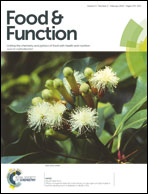A novel macromolecular extract screened from satsuma with pro-inflammatory effect
Abstract
Excessive consumption of horticultural fruit is a double-edged sword with both positive and negative effects. In Eastern countries, a large number of people have suffered from shang huo as a result of excessive consumption of “heating” foods, such as lychee, longan, mandarin orange, mango and civet durian. The present study adopted a step by step strategy screened the compositions with pro-inflammatory effect in satsuma fruits. The pro-inflammatory effects of all fractions were evaluated in RAW 264.7 cell lines by enzyme-linked immunosorbent assay (ELISA) and RT-PCR tests. The soluble water extract (SWE) from satsuma increased the production of prostaglandin E2 (PGE2) and promoted the expression level of cyclooxygenase-2 (COX-2) mRNA. SWE and high molecular weight molecules extracted from soluble water extract (HSWE) were respectively fractionated by dialysis bags and gel filtration chromatography. The macromolecular fraction named F1 was further obtained from HSWE, and could increase the production of inflammatory mediators. Finally F1 was resolved by SDS-PAGE and six proteins were identified by mass spectrometry. Compared with other detected proteins, polygalacturonase inhibitor (PGIP) and chitinase were the most likely candidate pro-inflammatory proteins according to molecular mass, and both of them were Citrus unshiu species. cDNA sequences of PGIP and chitinase were cloned and their functions were predicted as defensive proteins by SMART analysis. Excessive intake of these defensive proteins may result in adverse food reactions in human beings, such as shang huo and other immune responses.


 Please wait while we load your content...
Please wait while we load your content...